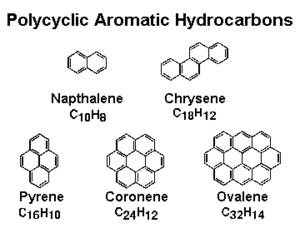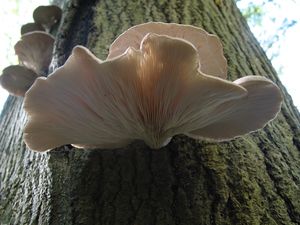Mycoremediation of polycyclic aromatic hydrocarbons (PAHs)
Introduction
Mycoremediation refers to the biodegradation of organic pollutants using fungi. Many pollutants enter the environment through wastewater effluent into water bodies or through leaks into the soil and are difficult to remove. These types of contaminants include polycyclic aromatic hydrocarbons (PAHs), which can be naturally occurring and released from volcanoes or forest fires and the burning of fossil fuels, or can be manufactured as antibiotics, dyes, or plastics among other uses (US National Library of Medicine, 2015). Some methods of getting rid of contaminated wastes or soils include landfilling or burning. However, these methods only relocate contaminants to another area or into the atmosphere if not burned properly. Using microbes, such as bacteria, to degrade the contaminants into less harmful compounds is another method but many pollutants are difficult for microbes to break down, either because they are physically inaccessible, toxic, or the microbes do not contain the enzymes necessary to degrade the compound. The latter may be the case in large polycyclic compounds which may not “fit” in the active site of many enzymes. Fungi may offer a better solution in a number of ways, such as (1) greater access to compounds in the soil than bacteria through the formation of extensive hyphal networks and (2) non-specific lignin degradation enzymes that are able to break down many structurally diverse compounds (Giubilei, et al., 2009; Harms, et al., 2011; Bhattacharya, et al., 2011).
Physical environment
Mycoremediation can be used in a wide variety of environments. One use is in treating wastewater, such as industrial effluent to remove toxic dyes and other compounds (Bhattacharya, et al., 2011), or raw sewage to separate the solids from the liquid, allowing easier transport and disposal of the solid waste (Molla & Fakhru'l-Razi, 2012). Other uses include the degradation of pesticides, such as cypermethrin in soils (Kaur, Sharma, & Parihar, 2015) and bioremediation of TNT contaminated soil (Anasonye, et al., 2015). Mycoremediation also has potential for treating PAH contaminated soils, such as remediation of the PAH antibiotic oxytetracycline from animal waste to help prevent antibiotic resistance in bacteria and other environmental harm (Migliore et al 2012).
Mycoremediation using filamentous fungi is of particular interest in soils as they are primarily soil dwellers and grow by extending hyphae--thread-like extensions that can cover hundreds of hectares (Harms, et al., 2011). A single fungal organism can cover such a distance and survive by rapidly translocating nutrients from nutrient sources to nutrient poor areas, and can also translocate contaminants in the same manner (Harms, et al., 2011).
Like some species of bacteria, some fungi can tolerate extreme conditions, such as temperatures of -5 to 60 °C, pH of 1 to 9, and oxygen levels down to 0.2% oxygen (Harms, et al., 2011). Some limiting environmental factors for mycoremediation activity include the requirement for at least a small amount of oxygen to be present, soil that is not often disturbed (e.g. by tilling, etc), and the presence of organic substrates other than the pollutant, such as wood chips or other lignocellulose material (Harms, et al., 2011).
Microbial communities
Most of the known fungal pollutant degraders belong to one of two phyla, Ascomycota or Basidiomycota, which are two of the largest groups of known fungi (Harms, et al., 2011). Ascomycetes make up about 64% of all known fungi and include species belonging to Penicillium, Aspergillus, and Cordyceps among others (Harms, et al., 2011). Basidiomycetes make up about 34% of all known fungal species, and contain the majority of mycorrhizal fungi as well as other primarily terrestrial species (Harms, et al., 2011).
One group of fungi of interest for mycoremediation, particularly for PAHs, is the genus Pleurotus, in the phylum Basidiomycota; also called white rot fungi, they are known for their ability to degrade lignin, a naturally occurring polyaromatic compound degraded using relatively non-specific extracellular oxidative enzymes (Cohen et al 2002). Pleurotus spp. are easy to cultivate and have many uses besides bioremediation, including culinary and medicinal uses (Cohen et al 2002).
Bacterial and Fungal Interactions
By changing the environment around them, fungi can stimulate and enhance the activity of other microbes, including other contaminant-degraders. One way they do this, besides transporting the contaminant to other areas, is by forming “fungal highways” that bridge air filled spaces and allow bacteria to access pollutants that may otherwise be inaccessible to them (Furuno, et al., 2012).
Microbial processes
Many of the compounds that are good candidates for mycoremediation are organic pollutants, such as aliphatic compounds, PAHs, or other aromatic compounds (Harms, et al., 2011). Many of the enzymes of interest for mycoremediation have low specificity, allowing the fungi to cometabolize a diverse range of compounds, including structurally diverse pollutants (Harms, et al., 2011; Giubilei, et al., 2009; Bhattacharya, et al., 2011). Some of these enzymes, such as oxidoreductases, peroxidases, and laccases, are used by white rot fungi to degrade lignin, a polyaromatic compound many bacteria cannot break down (Harms, et al., 2011; Bhattacharya, et al., 2011). The majority of the enzymes fungi use in biodegradation are extracellular, meaning initial breakdown occurs outside the organism, although the fungi may also absorb the compound before breaking it down (Harms, et al., 2011). PAHs are primarily degraded using extracellular oxidative enzymes, although use of laccases and peroxidases in PAH bioremediation is currently being studied (Cohen et al 2002; Harms et al 2011).
Current Research
Pollutants such as PAHs are minimally water soluble which makes it difficult for microbes to access and degrade them. These compounds can be made more available by adding surfactants to the soil, causing the pollutants to go into solution (Giubilei, et al., 2009).
There are many studies on the ability of microbes to degrade single contaminants, but a recent study examined the ability of a fungus to remediate a heavy metal and PAH co-contaminated soil (Chen, et al., 2015).
References
Edited by Billyann Monrean, a student of Mary Beth Leigh at the University of Alaska Fairbanks. Template adapted from one used by Angela Kent at the University of Illinois at Urbana-Champaign


